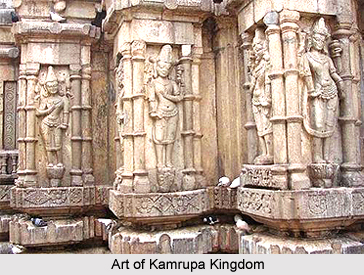 The history of Kingdom of Assam begins with the establishment of Pushya Varman`s Varman dynasty in the fourth century in the Kamarupa kingdom. It drew its ancestry from Narakasura. Under King Bhaskaravarman`s rule in the seventh century this empire reached the pinnacle. He died without leaving heir to ascend the throne and his successor was Salasthamba who was a minister in his empire. He had established the Mlechchha dynasty. As per historical records twenty one rulers of this dynasty have ruled kingdoms of Assam. This dynasty in Kamarupa was followed by the Pala dynasty.
The history of Kingdom of Assam begins with the establishment of Pushya Varman`s Varman dynasty in the fourth century in the Kamarupa kingdom. It drew its ancestry from Narakasura. Under King Bhaskaravarman`s rule in the seventh century this empire reached the pinnacle. He died without leaving heir to ascend the throne and his successor was Salasthamba who was a minister in his empire. He had established the Mlechchha dynasty. As per historical records twenty one rulers of this dynasty have ruled kingdoms of Assam. This dynasty in Kamarupa was followed by the Pala dynasty.
After the fall of the Mlechchha dynasty in the late ninth century, Brahmapala was elected as the ruler of Kamarupa who established the Pala dynasty. Unlike the Pala kings of Bengal who were Buddhists, the Palas of Kamrupa were Vaishnavas. The last Pala king was removed by the Gaur king, Ramapala. Timgyadeva was made the governor but he declined their supremacy and ruled the empire independently for some years. He was attacked and replaced by Vaidyadeva under Ramapala`s son Kumarapala. Timgyadeva and Vaidyadeva, ruled mostly autonomously though were established by the gaur kings. They had also issued grants under the old Kamarupa seals. The fall of succeeding kings and the rise of individual kingdoms marked the end of the Kamarupa kingdom and the period of Ancient Assam.
The rise of Khen dynasty of the Kamata Empire marks the beginning of medieval history of Assam. This was established by Prithu in the western part of the old Kamarupa Kingdom. The Kamata kingdom named after the capital at Kamatapur, was frequently attacked by the Turk rulers of Bengal. Alauddin Hussain Shah finally defeated the last Khen king in fifteenth century. He and the subsequent rulers could not strengthen their rule in this territory due to the revolt by the Bhuyan chieftains and other local groups.
Vishawa Singha established the Koch Kingdom in the sixteenth century. Koch dynasty reached its peak under his sons. His son Malladev was his successor took the name Naranarayana. His brother Chilaraya became the Commander in Chief of the Army and with the help of the Mughal army expanded the territory up to Gauda. After Naranarayana the kingdom has divided into Koch Hajo and Koch Behar. Koch Bihar became a vassal of the Mughals, and Koch Hajo came under the control of Ahom.
The Kachari and the Chutiya kingdoms arose in the eastern part of old Kamarupa kingdom. Kachari kingdoms were the earliest inhabitants of Brahmaputra Valley. They belonged to Bodo - Kachari ethnic group. By the 13th century they extended along the southern banks of Brahmaputra River, and included the valley of Dhansiri and present-day North Cachar Hills district. Kacharis established their capital first at Dimapur and later shifted to Maibong due to their conflict with the Ahoms.
The Ahom kingdom was established by Sukaphaa in the tract between the Kachari and the Chutiya kingdoms. They had spread out to the north and pushed the kachari kingdom further south. This dynasty was able to reorganize small territories under one kingdom and created Bar Asom by including Kampeeth, Ratnapeeth, Subarnapeeth and Saumarpeeth. Jorhat is considered as the last capital of this dynasty. The rule of Ahom kingdom is considered as revival of glory of the Kamarupa kingdom. The 17th century saw the Ahom-Mughal conflicts, in which the Ahoms stopped Mughals successfully. When the Ahom kingdom reached its After the Ahom kingdom reached its summit crisis arose within the kingdom in the 18th century.
Ahom lost its power to rebels of the Moamoria rebellion. Though they recaptured the kingdom it was weighed down with problems. This led to the Burmese invasion of Assam. With the defeat of the Burmese in the First Anglo-Burmese war and the following the Treaty of Yandaboo, Assam passed into the hands of the British, marking the end of the medieval period.



















